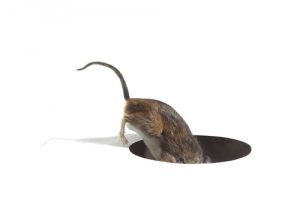How Do Mice Get Into My House?
By Chris Williams on January 18, 2011.
Q: How do mice get into my house?

A: Mice enter a house to escape from predators and the elements. Once mice get inside and find a nesting site, nuts and seeds may be stored in small caches nearby. The warmth provided by your heating system along with their stored food makes for nice living. Unlike mice outside in the wood pile, these mice can rest easy, even mate and have babies. The mice outside must constantly eat to stay warm while evading predators such as weasels, fox, fisher cats, cats, birds of prey and coyotes. Common construction methods often leave openings at corners, behind steps, at the roofline, chimney flashing, bulkheads, and garage door frames to name a few. Mice can get through openings as small as 1/4 of an inch wide, or the size of the human pinky finger tip.
Much can be done by the homeowner to correct these construction defects and prevent rodent entry. Smaller openings can be filled with caulking or other suitable material. Expandable foam, stainless steel mesh, copper mesh, metal flashing, and wood pieces are some examples of what can be used to exclude invaders such as mice, rats, red and grey squirrels, flying squirrels, and bats. Larger holes and gaps may need more attention, but time and money spent in this direction will go a long way in solving and preventing rodent damage to your valuable home. In most cases a quick inspection will reveal the construction defects that need to be addressed, as well as the magnitude of the infestation at hand. Exclusion is an excellent strategy in any Integrated Pest Management plan.